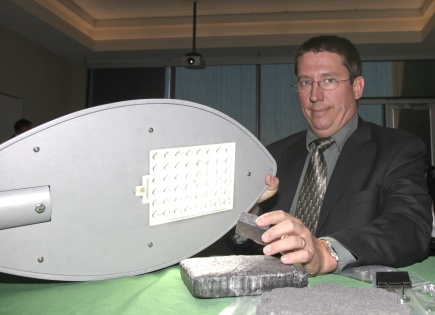号称使用寿命可达1万小时的LED,在一些汽车的前仪表板做为指示灯已经服务超过30年;但后来出现的固态照明应用高亮度LED(high-intensity LEDs),却因为运作在温度太高的环境而牺牲了好几年的使用寿命。
美国橡树岭国家实验室(Oak Ridge National Laboratory,ORNL)的研究人员最近宣布,他们已经利用一种石墨泡沫(graphite foam)材料,让LED的寿命能更进一步延长,甚至能让高亮度LED的运作温度降到像仪表板LED指示灯那样的水平,使它们用得更久。ORNL最近已将该石墨泡沫技术独家授权给由该实验室独立而出的公司——LED North America。
ORNL表示,将LED运作温度降十度,就能让其使用寿命延长一倍;如此各地方政府就能够将现有的水银路灯换成LED灯,以节省高达数百万美元的电费,又不须负担LED灯可能过热的技术不成熟风险。未来LED North America则打算利用低温运作的石墨泡沫散热片,提供新一代的路灯、车库灯解决方案,而且使用寿命又比其他竞争产品来得更长。

石墨泡沫类似发泡塑料(Styrofoam),重量轻且多孔,密度为25%;这使得该种材料很容易制作成散热片。这种纯碳材料制成的散热片,导热性能据说远优于传统的金属散热片;ORNL表示,该种泡沫“芯(wick)”的韧带(ligament),原本就是绝热的,而不是像传统散热片那样会跟LED一起升高温度。
点击进入参考原文:Graphite foam cools hi-intensity LEDs, by R. Colin Johnson
《电子工程专辑》网站版权所有,谢绝转载
{pagination}
Graphite foam cools hi-intensity LEDs
by R. Colin Johnson
Light-emitting-diodes (LEDs), once quoted to have 100,000-hour lifetimes, are still working today in some front-panel indicators after 30 years of service. But the advent of high-intensity LEDs for solid-state lighting sacrifices longevity by operating at temperatures too high for lifetimes much longer than a few years.
Now Oak Ridge National Laboratory (ORNL) claims to have rolled back the calendar on LEDs with a graphite foam material that keeps even high-intensity LEDs as cool as those used for front-panel indicators, thereby reclaiming their long lifetimes. ORNL recently granted an exclusive license for their graphite foam technology to LED North America (Oak Ridge, Tenn.) an ORNL-spinoff located in the adjacent Technology 2020 "incubator" park.
According to ORNL, decreasing the operating temperature by 10 degrees can double the lifetime of LEDs. As a result, municipalities can change over their existing mercury-vapor lamps for LEDs to save millions on their electricity bill without suffering premature failures due to overheating. As a result of their cool-running graphite foam heat sinks, LED N.A. aims to offer retrofits for street lights and parking garage lighting with warrantees that are longer than its competitors.
Graphite foam is light and porous like Styrofoam—with 25 percent density—making it easy to machine into heat sinks, but with the vastly superior thermal conductivity afforded by the pure-carbon material compared to conventional metal heat sinks. Ligaments in the foam "wick" heat away from its source, according to ORNL, rather than just heat up with the LED like a conventional heat sink.